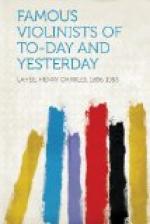Lulli is said to have been very avaricious, and his wealth included four houses, all in the best quarters of Paris, together with securities and appointments worth about $70,000. His death, in 1687, was caused by a peculiar accident. While conducting a performance of his orchestra he struck his foot with the cane which he used for marking the time. The bruise gradually assumed such a serious condition that it ended his life.
Jean Baptiste Senaille, who was a pupil of Anet, was born in 1687, and turned to the Italian school. In 1719 he entered the service of the Duke of Orleans.
Francesco Geminiani was considered the ablest of the pupils of Corelli, and was born about 1680. When about twenty-four years of age he went to England, where his talent secured a great reputation for him, some people even declaring him to be superior, as a player, to Corelli. He lived to an advanced age, and was in Dublin visiting his pupil Dubourg at the time of his death. He was a man of unsettled habits, and was frequently in dire necessity, caused chiefly by his love of pictures, which led him into unwise purchases, and thus frequently into debt.
About the year 1650 three violinists were born in Italy, who all left their mark upon the history of violin playing.
Tommaso Vitali was born at Bologna, and was leader of the orchestra in that city, and later in Modena.
Giuseppe Torelli was leader of a church orchestra in Bologna, and afterwards accepted the post of leader of the band of the Markgraf of Brandenburg-Anspach, at Anspach, in Germany. To him is generally ascribed the invention of the “Concerto.”
Antonio Vivaldi was the son of a violinist, and sought his fortune in Germany, but returned to his native city in 1713. He wrote extensively for the violin, and is said to have added something to the development of its technique. An anecdote is told of him to the effect that one day during mass a theme for a fugue struck him. He immediately quitted the altar at which he was officiating, for he united clerical with musical duties, and, hastening to the sacristy to write down the theme, afterwards returned and finished the mass. For this he was brought before the Inquisition, but being considered only as a “musician,” a term synonymous with “madman,” the sentence was mild,—he was forbidden to say mass in the future.
The most illustrious pupil of Vivaldi was Francesco Maria Veracini, who was born about 1685. He is said to have been a teacher of Tartini, who, if he did not actually receive instruction from him, at least profited by his example.
Veracini’s travels were extensive, for he visited London in 1714 and remained there two years, during which time he was very successful. He then went to Dresden, where he was made composer and chamber virtuoso to the King of Poland.
While in Dresden he threw himself out of a window and broke his leg, an injury from which he never entirely recovered. This act is said to have been caused by his mortification at a trick which was played upon him for his humiliation by Pisendel, an eminent violinist, but this story is discredited by some of the best authorities.




